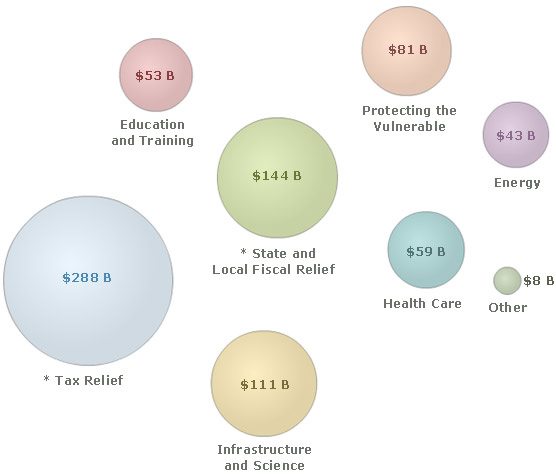
Photo courtesy Recovery.gov
It’s been five months since the American Recovery and Reinvestment Act (ARRA) of 2009, which delivered the largest increase in basic research funding in American history—$21.5 billion.
So what’s happening with the science money?
According to The Science Coalition, ARRA research grants are creating new university jobs, creating thousands of research awards, expediting tens of thousands of grant applications, buying equipment, and supporting some $3.5 billion of science-related construction projects for research facilities and capital equipment.
And that’s not all. The Department of Energy is establishing 16 Energy Frontier Research Centers on university campuses to accelerate development of new energy technologies. Each center will support a full staff of researchers, technicians, and grad students and postdocs.
The National Institute of Standards and Technology is using ARRA funds to support the construction of major new academic research facilities in Alabama, Florida, North Carolina and Texas.
Some 3,000 college students, high school students, and teachers in 49 states, D.C., and Puerto Rico, are participating in ARRA-funded summer jobs programs, getting lab experience at the nation’s leading biomedical research facilities.
Here’s a small sample of projects funded by state:
- West Virginia: $751,506 to Marshall U in partnership with West Virginia University to support 50 undergrad students and high school science educators for the next two years studying disease processes such as cancer and cardiovascular disease
- Minnesota: $362,400 to the U of Minnesota to create jobs and encourage students from minority and underserved communities to pursue careers in health-related sciences, including internships in cancer research for 10 undergrads and high school teacher training in cancer biology
- Ohio: federal stimulus money is fueling 15 NIH research projects at the Ohio State U this summer and supporting the lab work of five central Ohio science teachers and 49 students high school and college students
- Tennessee: $1.5 million ARRA grant to the U of Memphis to fund a six-year program to recruit, train, and support secondary education math and science teachers for the Memphis City Schools
- Michigan: $900,000 grant to Michigan Technological University to train 24 students and 12 professionals to teach STEM disciplines in high schools
- California: a grant to the U of California Santa Barbara Cal Teach program providing $10,000 fellowships for 75 teacher candidates pursuing masters degrees
- North Carolina: a $17.5 million grant to the University of North Carolina Chapel Hill for a center focusing on developing solar fuels from next-generation photovoltaic technology, supporting about 30 postdocs and grad students
- Massachusetts: a $19 million grant to fund the Center for Excitonics at the Massachusetts Institute of Technology, looking towards new materials for converting solar energy to electricity and for electrical energy storage
- Michigan: $19.5 million to the U of Michigan to study solar energy research, supporting 22 researchers studying nanoscale materials to determine their potential for converting solar energy into electricity
- Missouri: $20 million to Washington University in St. Louis to establish the Photosynthetic Antenna Research Center to study forms of energy based on the principles of light harvesting and energy funneling, plus educational outreach to K-12, undergrad, and grad levels
- Florida: $15 million to the U of Miami toward a Marine Technology and Life Science Seawater Research Building
- Alabama: $14 million to Auburn U toward the development of a Center for Advanced Science, Innovation and Commerce
- Texas: $11 million to Rice U toward the new Brockman Hall for Physics
- North Carolina: $15 million to the U of North Carolina Wilmington for a new facility for the Marine Biotechnology in North Carolina program
And more:
Alabama: $1.45 million in NSF awards to two U of Alabama professors in grants to further their research in the fields of chemistry and biological sciences
California: 50 ARRA-funded research grants to the U of California Los Angeles totaling about $20 million for the purchase of a supercomputer and for the math department to jumpstart grad students into research
California: DOE’s SLAC National Accelerator Laboratory housed and run by Stanford U gets money for major research equipment, seismic upgrades to lab, and nearly 100 open job positions. Plus 18 Stanford U School of Medicine projects stalled by budget shortfalls are moved forward
Colorado: $10.44 million to the U of Colorado Boulder to conduct studies ranging from the diagnosis of learning disabilities and climate change in the tropics to minimizing pain
Georgia: $3.7 million to the U of Georgia for the purchase of lab instruments and for research projects including studying the immune response, AIDS vaccines, and developing materials for renewable energy
Hawaii: $5.5 million to the Hawaii Natural Energy Institute at the U of Hawaii-Manoa for a Smart Grid demonstration project
Louisiana: $1.3 million to an associate professor at Louisiana State U (Health Sciences Center New Orleans’ School of Medicine) to develop new immunotherapies, including a vaccine, for cancer
Maryland: $21 million to the Johns Hopkins U (which receives more federal R&D money than all other universities), to hire more researchers
New Hampshire: more than $3 million to the U of New Hampshire for research into, among other things, climate change impacts and predictions
New Jersey: $3 million to Princeton U engineers to study how nanocatalysts can help supersonic jets fly faster and make diesel engines cleaner and more efficient
New York: grants to Rensselaer Polytechnic Institute for research into infectious diseases and cancer risks
New York: the State University of New York received dozens of grants supporting summer lab experiences for educators and students and for research in biomedicine, public health, and energy
Pennsylvania: $30 million to the U of Pennsylvania funding more than 100 studies in gene therapy, robotics, public education, neurological disorders, and tobacco’s effect on health
Virginia: $199,951 to the U of Virginia to study (what else?) the impact of stimulus funding on employment in science and engineering fields
West Virginia: $3 million to West Virginia U to study the biological effects of exposure to nanoparticles of tungsten carbide-cobalt
Wisconsin: $35 million to universities in Wisconsin, including to UW-Madison and work on breast cancer risks











